Kicking off this March 13 is the new edition of CPH:DOX in Copenhagen with an Inter:Active section that once again takes a closer look at the impact of art and technology on our society.
Once again we met with Mark Atkin, Inter:Active curator and Head of Studies at CPH:LAB (here is our interview with Maïwenn Blunat, CPH:LAB and Interactive exhibition Manager).
We discussed with Mark a lineup that once again focuses on artists from marginalized communities to give voice to their vision and open a discussion on the relationship between bodies and society, the red thread of this 2024 Inter:Active.
But we also took a look at the Adelaide Fringe Festival’s Electric Dreams program, running until March 17, which with its full dome paves the way for new audiences to the immersive field. Finally, we found out more about Immersive Arts, of which Crossover Labs, that Mark directs, is part: a government fund to encourage the creation by emerging artists of new immersive productions.
Here’s what Mark told us.
Full immersion in the Dome experience: an overview of the Electric Dreams Festival
MARK ATKIN – The Electric Dreams Festival in Australia is still ongoing and there is time to visit until March 17.
This year we have a 10-meter full dome, which can accommodate 40 people lying on bean bags. A wonderful experience. The dome has absolutely fantastic definition and incredible sound quality! The location, too, works very well. The Electric Dreams Festival happens in an old building, the Masonic Lodge, where there is a ballroom with a very high ceiling and an extremely strong floor, designed to accommodate people dancing. We were able to put the dome in there, and it was amazing – it looked like a spaceship had landed in the middle of this Victorian building, and the contrast between the old and the modern was really striking.
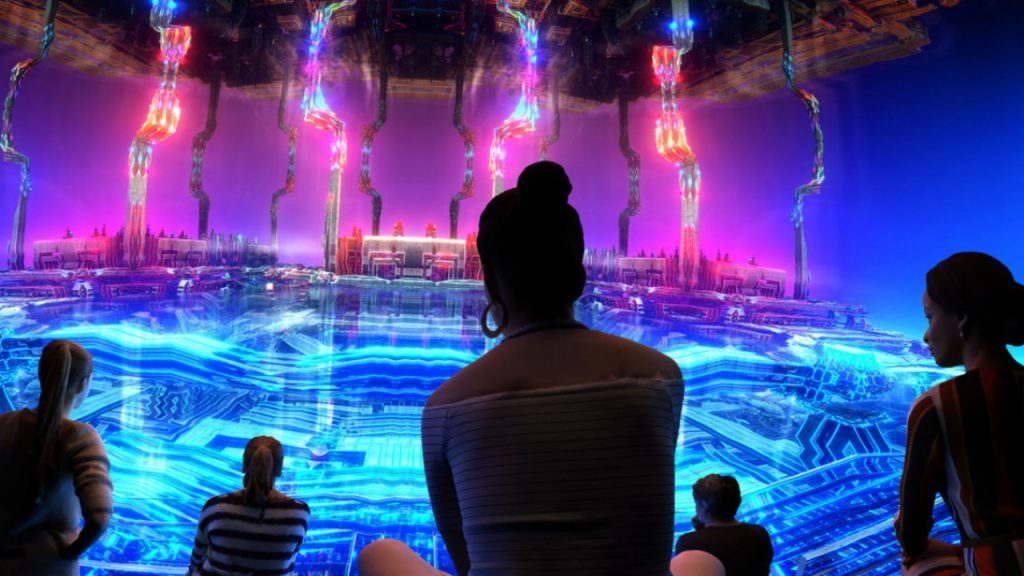
The beauty of this full dome is that when you are lying on the bag, it completely occupies your entire field of vision. The feeling is incredibly immersive. To me, the dome is like a giant VR headset that allows you to have an immersive experience without having to wear a lot of equipment. And I think that’s why people like it. I also saw it happen at the SILBERSALZ Science & Media Festival in Halle, Germany, where there is a brand-new, beautiful planetarium on which we held a science film program: people loved it, it was an extremely popular event.
The Dark Side of the Moon at Electric Dreams
M. A. – The lineup for the dome features nine films, some documentaries, some of which take place underwater and were made in Australia. We find, for example, NINGALOO – AUSTRALIA’S OTHER GREAT REEF, about the coral reefs of Australia’s west coast, an ecological work that shows how incredibly beautiful that area is. Then we have WHALE SUPER HIGHWAY, which examines the migration of whales up and down the west coast of Australia. There is another work called STAR DREAMING, which talks about how indigenous people read the stars. Absolutely brilliant.
We also have a piece made 10 years ago by Lynette Wallworth, creator of COLLISIONS, which is a superb VR piece, and AWAWENA. As an artist, she creates in many different formats, and 10 years ago she made a dome film titled CORAL – REKINDLING VENUS, about fluorescent coral reefs shown through the hypnotic music of Max Richter, Antony and the Johnsons, Gurrumul, Fennesz & Sakamoto and Tanya Tagaq Gillis. Although it is a work that is now 10 years old, it still remains absolutely valid and it’s incredibly beautiful.
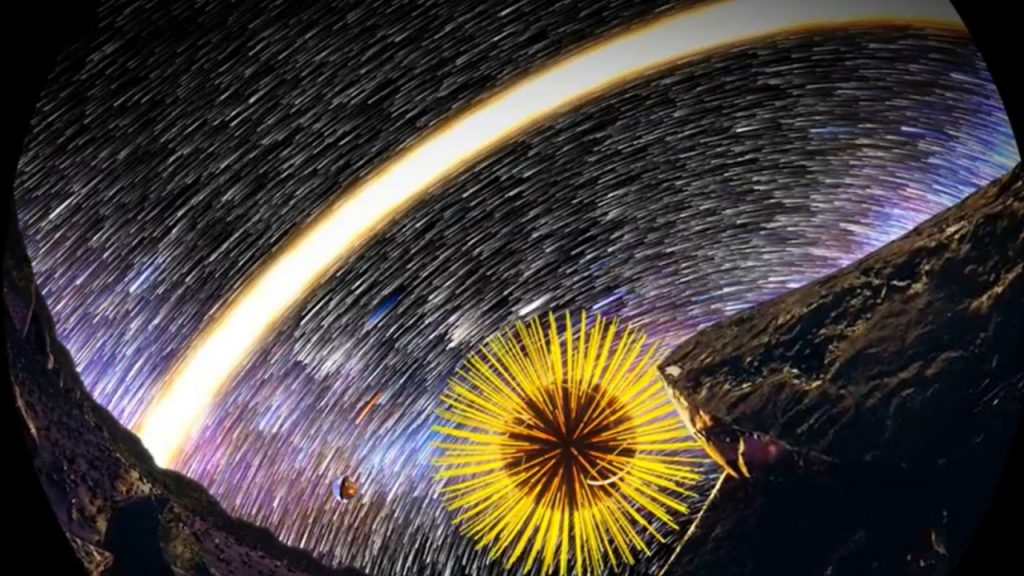
But the work everyone wants to see is THE DARK SIDE OF THE MOON, created by the National Space Center in Britain for the 50th anniversary of the release of Pink Floyd’s eponymous album. The work done by the National Space Center’s team is extremely good and smart; they know exactly what they are doing. They have created many immersive products in the past and things in VR that are quite artistic, but in this case they really outdid themselves.
The work brings back two parallel themes. One is about Pink Floyd itself: the film is full of little snippets of images from the entire history of the band, which speaks the most to their fans. But the work is also obviously about lunar exploration precisely because it comes from the National Space Centre. It’s a work that literally everyone loves. As soon as we put the tickets on sale, they started to sell out. So we had to organize more sessions, and every single session sold out! But the good thing is that once the viewers see the film, they fall in love with the idea of the dome itself and so they systematically buy tickets for all the other films we showed.
As part of the Electric Dreams line-up we also had IN PURSUIT OF REPETITIVE BEATS (Darren Emerson’s VR documentary about the Acid House scene in the UK in the 80s and 90s – which is also showing at PHI right now). Finally, ROBOBINGO by FoxDog Studios, which is a performance in which you play along on your phone. It starts looking a bit like a bingo game but quickly descends into anarchy while you all try to help a depressed robot find his best friend. It’s absolutely hilarious and also won the Best Comedy award in the first week of the Fringe!
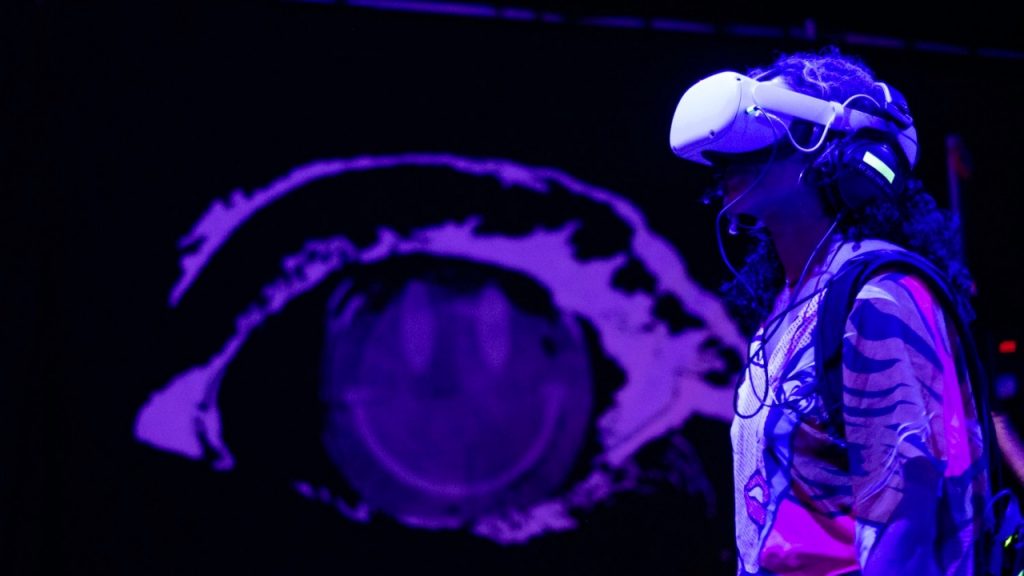
Crossover Labs / Immersive Arts: the importance of supporting emerging artist and the creation of artwork
M. A. – Immersive Arts is a government grant to stimulate the creation of new immersive artworks by emerging artists. It is now the main source of public funding directed to immersivity in the UK and is linked to training and to the marketplace. The activities that we as Crossover Labs do, just like at CPH:LAB, are very much related to that, to training, but always related to the marketplace.
So a fairly large consortium was formed that took the name of Immersive Arts and is led by UWE, the University of the West of England in Bristol, which is also home of the Pervasive Media Studios.
There is a very important creative cluster in Bristol for immersivity, but there are also partners in every country in the UK. There is a partner in Wales, one in Scotland, and one in Northern Ireland. So it is quite a comprehensive initiative to find new voices and to enable creative expression of people from all over the UK. This is a very recent initiative and we haven’t published the first call for proposals yet, but we are organizing to do that.

One of the problems with immersivity, which is not found in the film or television industry, is related to the development of a work in relation to potential funding. Usually there is funding, you give it and then wait for a final product to be delivered. What is missing is that intermediate process that looks more closely at the production process and analyzes the quality of what is being made as it is made and its effectiveness.
Television is very strong in this regard: there are always one or even two executive producers constantly reviewing the work as it is being developed, discussing how it is doing, how it is working, and how it will reach the audience. With immersive productions, on the other hand, this does not happen. Often nothing is shown until the end.
As part of this Immersive Arts program, here that’s what we are doing, we are part of this process. Initially we will work with a large number of small grants to develop new ideas, and then we will move to the development phase. Gradually the grants will get bigger and bigger, increasing as the process progresses. And this is all done constantly with input from people in the industry to make sure that these works are actually getting stronger before they are concretely launched into the world.
Welcome to a new edition of CPH:DOX Inter:Active: the relevance of art and marginalized artists
M. A. – The Inter:Active exhibition has always focused on creativity and technology. It deals with the impact of the arts and technology on society, specifically, and once again, this year, it was very carefully curated. Our curatorial line allows us to capture and examine some of the issues related to the impact of the technologies that artists are grappling with today, and it’s a curatorial line that obviously takes into consideration some of the works you’ll find elsewhere in the CPH:DOX line-up. Another thing that characterizes us is that CPH:DOX Inter:Active is all about art and about artists creating art-it’s something that we feel very strongly about and that sets us apart from other events.

In this regard, we are particularly interested in the work of emerging artists, people on the margins and people from marginalized communities, because these are the communities that are most affected by the influence of technology. If you are queer or if you come from immigrant communities, if you are differently-abled or even if you are a woman or a young person, you see very clearly how society is not working for you. Many of these artists, then, make this awareness the subject of the art they create, and that’s what I’m particularly interested in showing to our audience.
The other thing we try to do with the exhibition is to include, as long as of course they fit within the specific curatorial vision of the edition we are working on, productions that have been developed through the CPH:LAB: if a work is ready and fits, we are thrilled to host it in our lineup!
“Who do you think you are?”: reflecting on bodies at CPH:DOX Inter:Active
M. A. – This year our interactive exhibition is titled “WHO DO YOU THINK YOU ARE? The Body Reexamined,” and it is an analysis of our changing relationship with our bodies and how they are reflected and experienced in society.
I think this is a time when many people talk about their lived experience as something to express despite the difficulty and refusal of many to listen. But today more than ever it is important to listen: society is becoming completely fragmented and atomized, there are so many things that drive us apart! But if we can better understand the lived experience of others, then perhaps that will lead to greater empathy in everyone. In my opinion, there is nothing better than embodied media that specialize in the immersive area to actually reflect people’s lived experience.
We divided the experiences of the lineup into four main sections, namely:
- Dystopian Bodies: Bodies in perplexing imagined futures
- Unbounded Bodies: Reappraising attitudes to dis/abilities, bodily functions, gender and desire
- Hybrid Bodies: Things going awry as we merge with the digital
- Entangled Bodies: Our bodies enmeshed in nature
Dystopian Bodies: bodies in perplexing imagined futures
M. A. – The first section, Dystopian Bodies, is about bodies imagined in a dystopian future. The first work in it is FINITE HORIZON, by an artist named Astria Suparak, who is American but of Thai descent. She has created a series of works that are part of a more global work called Asian Futures Without Asians. She analyzes how Western popular culture has imagined the future, specifically a dystopian future influenced by Asian cultures, and what she shows us is that it is a future either extremely criminal, full of sin, or white men eating noodles with chopsticks. Astria is coming to speak at the symposium on Monday the 18th: her work is extremely interesting, one of those works that makes you wonder, “Why didn’t I notice this earlier when it is so obvious?”. I can’t wait to meet her!
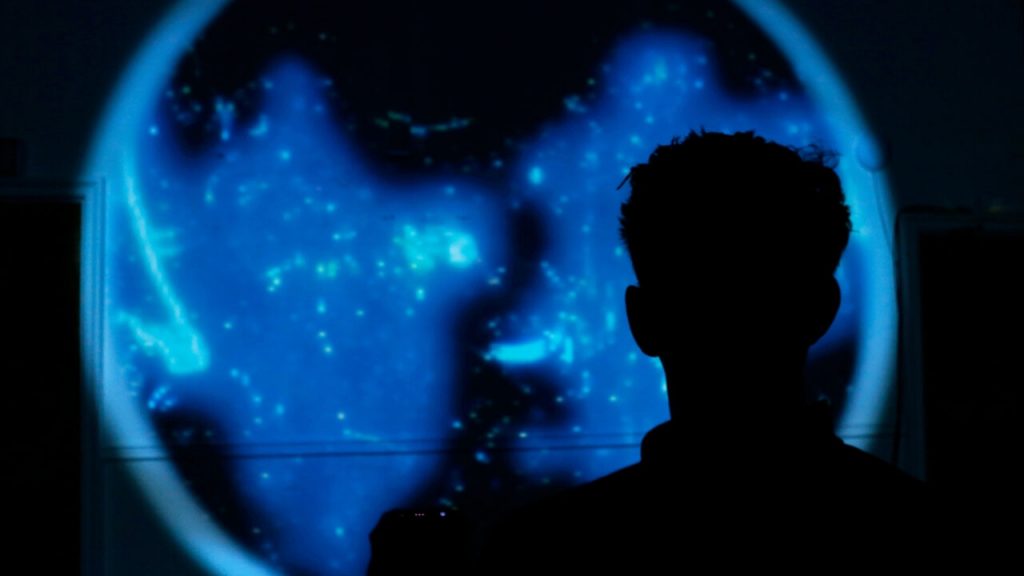
Another project in this category is called THE PATHOGEN OF WAR. It came through our lab a couple of years ago. The artist, Yasmin Fedda, shows how war itself can spread disease, imagining a future scenario where this type of disease has overtaken our resistance to antibiotics. The work looks from the future to a real and imagined past to understand how this situation came about. To me it is more than just an installation, it is almost a piece of immersive theater without actors, but full of many elements to interact with over the course of about 40 minutes. The piece was programmed in London’s Battersea Arts Center a few months ago, which is fantastic, because it’s one of the best venues in the UK for these kinds of productions. I’m excited to see it come to CPH:DOX, now, and hope that after this event it will spread further around the world.
Hybrid Bodies: things going awry as we merge with the digital
M. A. – The next category is called Hybrid Bodies, which is kind of related to dystopia and is about the problems that occur when we start to merge our bodies with the digital world.
There is a work that I am very excited about, by a Danish artist called Cecilie Waagner Falkenstrøm. It is I SEE IT, SO YOU DON’T HAVE TO, and it’s a real 2×3 meter tapestry which analyzes one of the biggest problems in artificial intelligence, the work of moderators. These are micro-workers who moderate data and content for the AI industry-a poorly paid job that takes a huge toll on mental health and well-being.
She looks at this through a tapestry she created with Jacquard loom, which is in a sense the forerunner of artificial intelligence. It’s a deeply complex work, with many layers, and I’m excited to have something exclusively textile on display.
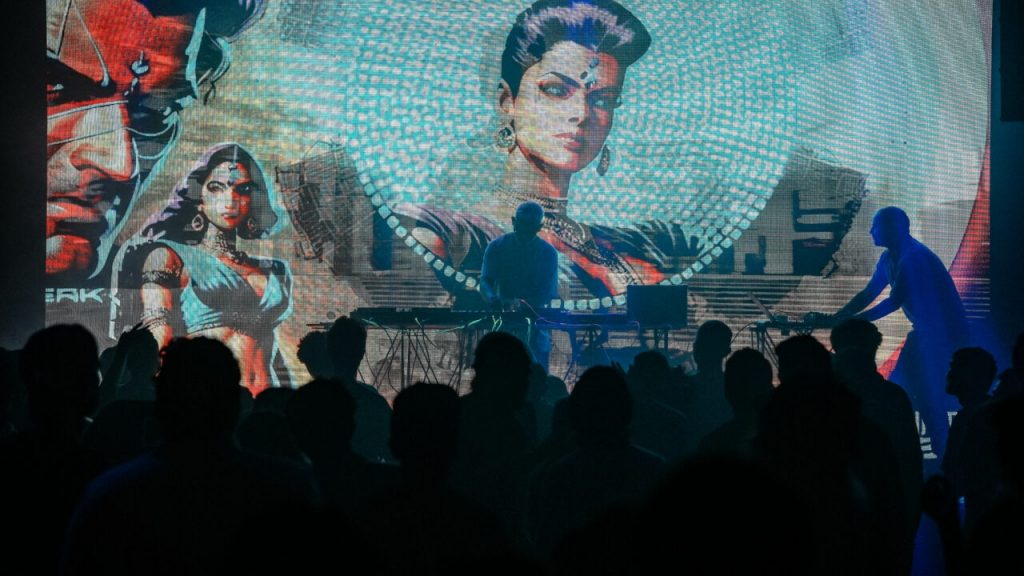
Another work on the topic of artificial intelligence that we have is VOCALIZE, also a project that came from our LAB under the initial title of UNSTABLE EVIDENCE (a/n we talked about it last year, presenting the works developed during CPH:LAB 2022-2023). You are recruited as a voice actor for a company. You walk into a room and record your voice, only to find that this part of you is captured by artificial intelligence and begins to have a life of its own, which may or may not be something you are comfortable with. The project highlights a whole range of issues related to artificial intelligence.
There is another project from LAB, but this time from this year’s LAB, that we are presenting in the exhibition, because it is also about AI, its uses and abuses, and the misunderstandings that come with it. It is called ANAMNESIS. We decided to present it during this edition of CPH:DOX Inter:Active because it was made with the latest AI tools and if we wait a year things will already be very different.
IWe are delighted to be able to present it in this iteration, but by the very nature of the theme it will always continue to develop and change. It’s the way AI is affecting the production process, in a way. What it allows you to do changes from day to day, and how you want to comment about it also changes from day to day. These two things, when put together, mean that today it looks like this and in three weeks it will look completely different. The work analyzes the way one interacts with artificial intelligence, the kind of prompts we use and the degree of empathy we should or could have for a machine, with its consequences.

Finally, there’s another work that examines some of the misunderstandings that occur when using AI, ANA MIN WEIN? (WHERE AM I FROM?). It’s a video art work made by a young woman of Saudi origin living in America, who is examining her family history. When she tries to use artificial intelligence to extract elements of her past, there is a lot of misunderstanding about the way artificial intelligence sees the world: it is definitely not through the prism of an Arab woman. And then they look at the consequences of that. It is another beautiful work by a woman, one who is also very young and very talented.
Unbounded Bodies: reappraising attitudes to dis/abilities, bodily functions, gender and desire
M. A. – The next category is called Unbounded Bodies and it’s made up of works where artists examine physicality and what can and cannot be talked about, rejecting the attitude that wants the disabled person to be someone who is so by nature, rather than someone made so by society. Can disability provide a different way of seeing the world that has any value? And what about bodily functions, gender and desire and how they change through society, time and our personal attitudes?
One of the pieces featured is called UNBUILT ENVIRONMENTS. It’s a video art built in Unreal, and it’s by a disabled artist, Alistair Gentry, who interviewed various disabled artists and asked them what image underlies the idea of disability and what makes a specific person disabled. Most disabled people think that it is society, the way it is structured, that makes them disabled. Starting from this point of view, therefore, the project looks at different physical environments, reflecting on how they actually make people disabled and how a better world can be created. It also looks at some dystopian images of disabled people, for example in horror movies. This is a work that comes out of the imagination of a group of disabled people, and Alistair Gentry will be speaking at the Symposium about his work with disabled artists and the making of this Unbuilt Environments.
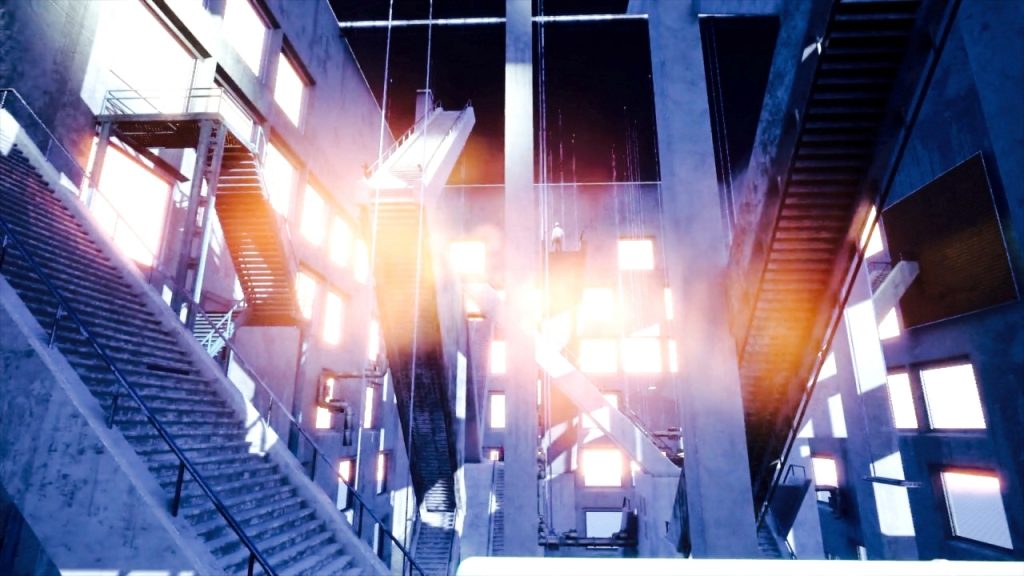
We also have a piece created by Ben Joseph Andrews and Emma Roberts, TURBULENCE: JAMAIS VU, in which the artist reflects on his experience of vestibular migraine, which presents itself as a form of extreme disorientation. He tries to reproduce for the audience the beginning of one of these episodes, where you can’t trust your body in the world. I think this problem allows him to see the world differently even as an artist and in fact it is something that strongly influences his artistic production and in particular his use of virtual reality, which is extremely challenging for him.
THE SOUND VOICE PROJECT is another work presented in this category. It is an artistic documentary about people who have undergone a laryngectomy, that is, who have had their larynx removed and therefore can no longer speak, have lost their voice and have had to understand what it means for them, for their identity and for the way they relate to society when there is no longer a voice to do so. This very inspiring work is also related to transformational work of a doctor who has brought opera singers, who learn to sing from the belly, together with patients who have undergone laryngectomy, to help them regain a new kind og voice. He put them together to create a chorus of laryngectomized patients who have found a new way to push air through their throats and out into a new form of sound that allows them to reconnect with society and the people around them. It is a very beautiful piece and one that is also very moving.
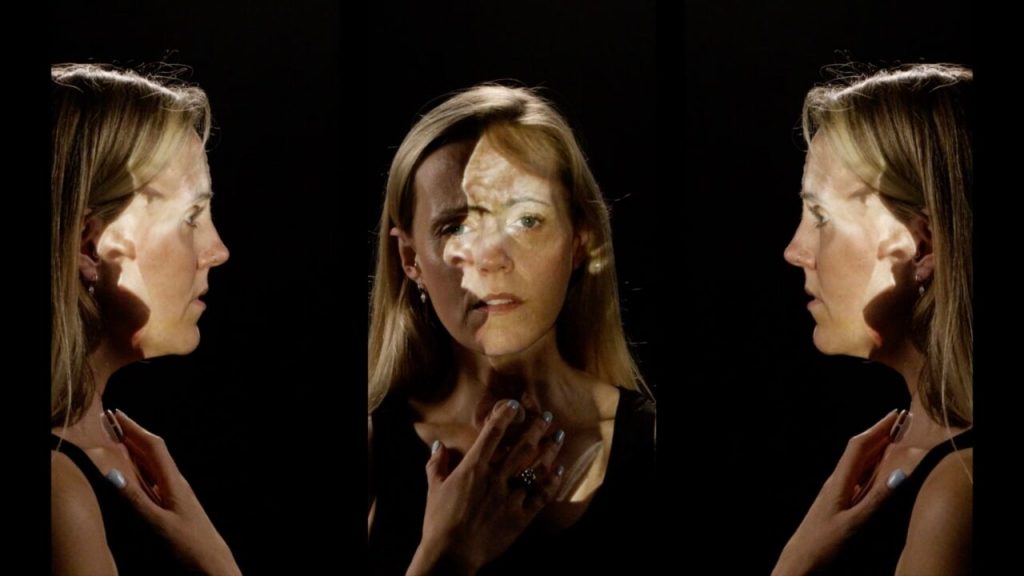
We then have BLOOD SPEAKS by Poulomi Basu and CJ Clarke, which focuses on the body as a site of resistance, especially for women, specifically examining the stigma associated with menstruation. Its focus is VR, but around it is an installation that examines the experiences of women who have been rejected by society because of an innate and valuable physical process. People don’t like to talk about certain issues, but Poulomi Basu addresses them in an absolutely straightforward way, which I very much appreciate.
Another thing that people don’t like to talk about and which unfortunately is very common is endometriosis, a condition that Jess Coldrey discusses in INTO THE RABBIT HOLE. Again we have a textile work through which the artist tells of their experience of living with the pain brought to the body by this disease. On the textiles, which represent the intense experience related to periods of endometriosis, Jess uses an artificial intelligence that tries to recreate a representation of the mental state provoked by this issue.
Then, of course, we also have productions from queer artists. There is Lui Avallos, who is currently in our LAB with FOLLOW THE CARNATION. His previous work, QUEER UTOPIA, was exhibited at the Venice Immersive 2023 (La Biennale di Venezia) and is about an older gay man who is losing his memory and wants us to help him reconstruct the moments when he was trying to come to terms with his sexuality and the fear and joy that came from those explorations.
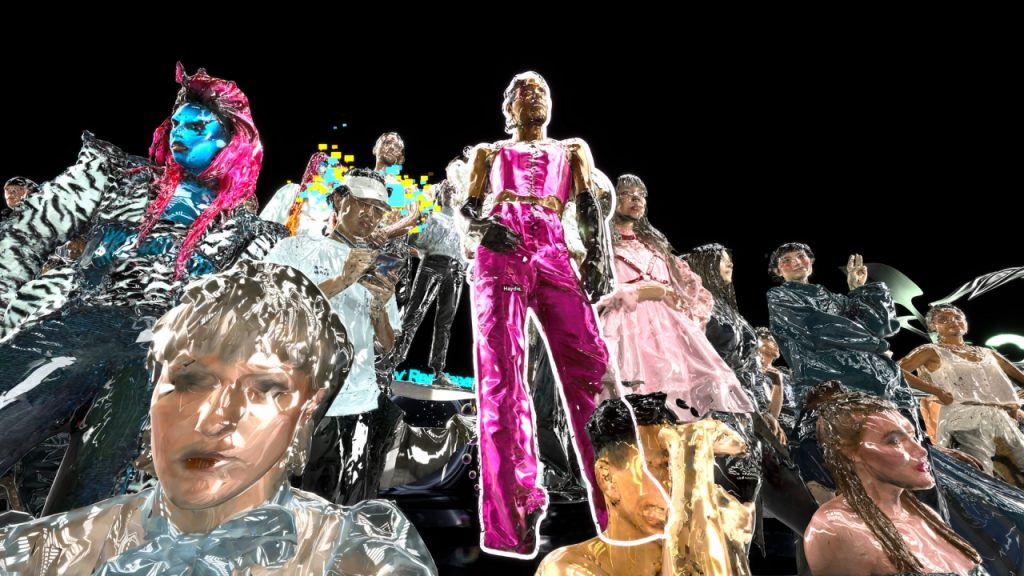
We also have a piece called GLITCHBODIES by Rebecca Merlic, which is a celebration of different kinds of gender expression. It looks like a game, but it is actually a series of artistic tableaus of artists from across the spectrum of female and queer identification, and a celebration of their physicality and worldview.
The last production in this category is the game ANTIPSYCHOTIC by Matt McCorkle, which deals with bipolar disorder and was made by a person with this condition. It uses game dynamics and haptic feedback to get you into their imaginative expression of what it feels like. The couch that you are sitting on vibrates at certain times in the game, which, of course, makes you tune into different aspects of what is happening. It’s one of those things that sticks with you.
Entangled Bodies: our bodies enmeshed in nature
M. A. – The last area we explore at Inter:Active is called Entangled Bodies, and it reflects on our bodies in relation to nature. It includes two works: the first is INTANGIBLE by Carl Emil Carlsen, another Danish artist. The other is GARDEN OF GHOSTS FLOWERS: THE EMBODIMENT ARCHIVE, a work that was developed at CPH:LAB a few years ago and is part of a much larger project.
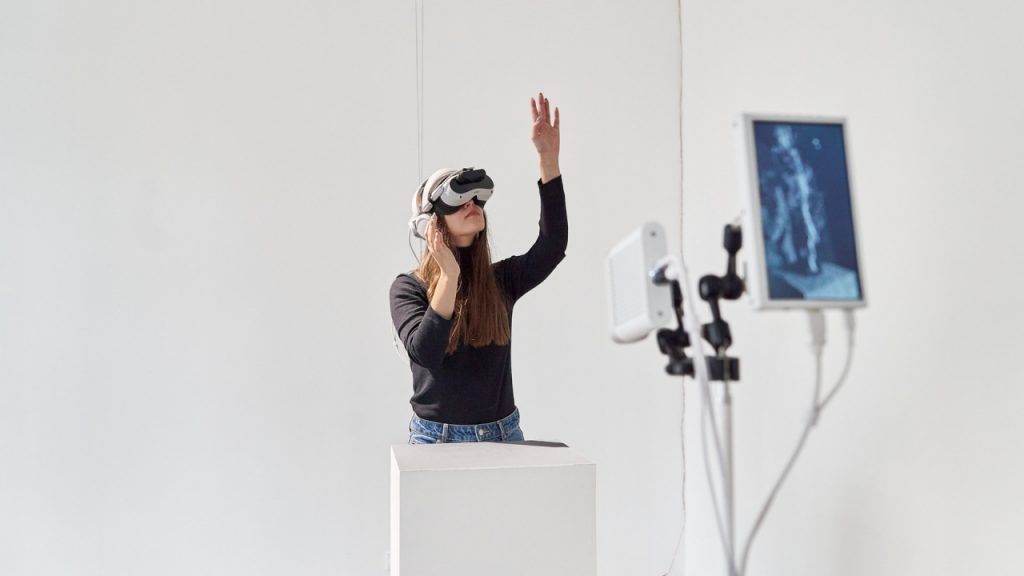
Both works use digital tools to analyze how we can connect with nature and become one with it. INTANGIBLE is a sensory experience that investigates the paradox of wanting to feel nature, but doing it through computational means.
GARDEN OF GHOSTS FLOWERS analyzes resonance and how we can tune in to the natural world around us and the network of mycelia and become part of it.
New trends in immersive storytelling
M. A. – There are many more productions, today, that use artificial intelligence in different ways and comment on some of the pitfalls of its rapid spread. This is the most obvious and visible evolution of storytelling that has occurred in recent years. .
Another of the aspects that we looked at, particularly during the 2023 edition of CPH:DOX Inter:Active, is how the game engine is being used more and more by artists, and this is still the case today. The trend of the game engine becoming the most common form of artistic expression continues, and I don’t see it changing, particularly considering how new generations of artists literally have grown up with these formats and are naturally drawn to this form of expression.

Another aspect that comes to mind that I find reflected in our lineup is the tendency to a deeper introspection. It reflects the attitude of artists right now: they are looking inside themselves and at how to negotiate with a divided society. I think this attitude is a reaction to what we saw happening in social networks for several years: so much time spent looking at the surface of things on Instagram, Tik Tok. Everything is glossy, and the attention span is short. The sexy things are the ones that get the attention. So the tendency, today, is to adopt a different attitude, becoming more reflective, digging into the depths of ourselves and exposing something that is deeper but, ultimately, also something that we can all relate to much more.
Evolution of technology and marginalized communities
M. A. – I think the situation is improving, because the expressive tools, the access to game engines, etc., have a low entry barrier and cost very little so it’s quite easy for artists to appropriate those tools of expression, and they are doing that.
This is reflected in the kind of work we exhibit in Copenhagen. But of course we’re not the only ones in the world doing that, and it’s much easier now for emerging artists to get noticed and have their work shared more widely. In this regard, two of the artists we had with us last year have taken a huge step forward in their careers in recent months. Danielle Brathwaite-Shirley, featured at CPH:DOX Inter:Active with HIVEMIND, is having their first solo exhibition in London. Jake Elwes’ THE ZIZI SHOW was acquired by the V&A Museum, which is huge. So I think the answer is that things are, after all, getting better.
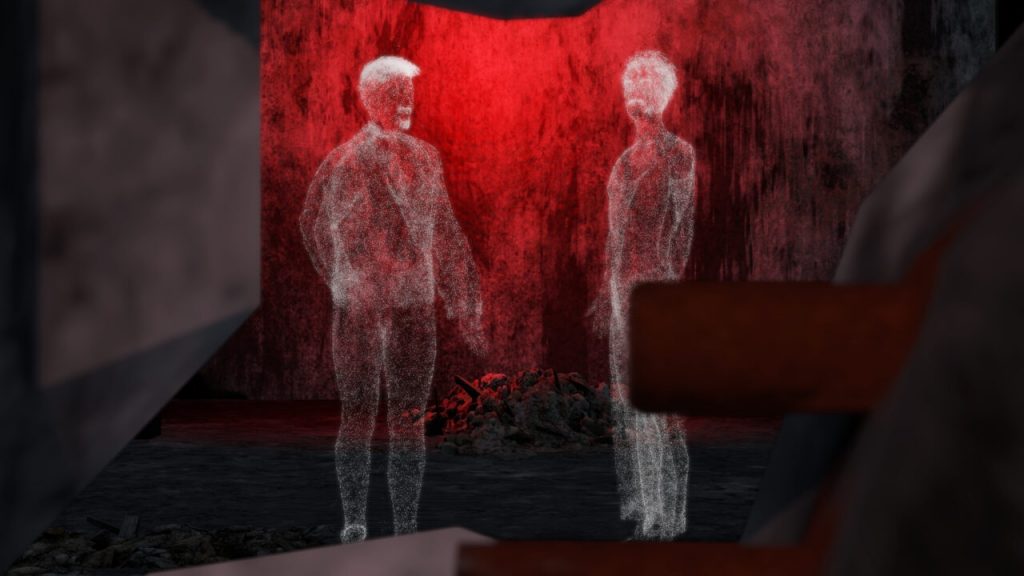
You can find more information about the Inter:Active lineup and purchase your tickets on the CPH:DOX website, which will take place in Copenhagen from March 13 to March 24.
If, on the other hand, you are on Australian soil, you still have a few days to catch up on the exciting Electric Dreams Full Dome experience. Tickets available for purchase here.

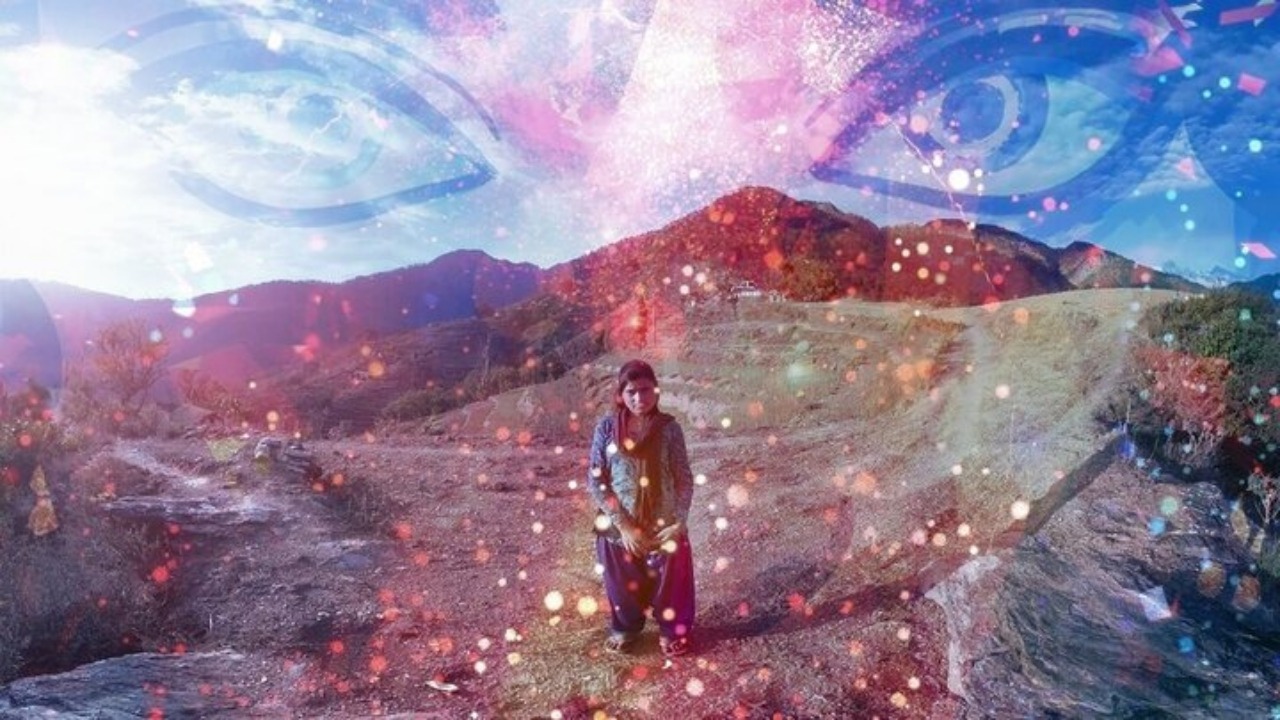

Leave a Reply
You must be logged in to post a comment.